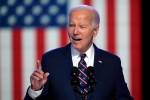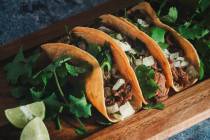Prized Kobe beef returning to Las Vegas restaurants



The staff meal – or "family dinner" – tends to vary widely from restaurant to restaurant and even from night to night. But a recent meal at Social House will no doubt linger in the minds of employees. That’s because it was A-5 Kobe beef, straight from Japan.
Two years after U.S. imports of Japanese Kobe and/or Wagyu (more on that later) were suspended because foot-and-mouth disease had been found in Japanese cattle, the premium beef has begun to return to Las Vegas restaurants. Social House, in Crystals at CityCenter, was one of the first to get it, on Sept. 14.
"It is A-5 Kobe; it is the real deal," said Robert Marino, assistant general manager.
Marino said the restaurant received a 15-pound cut.
"Traditionally, you’re going to get 25 to 35 percent loss on that, in trimmings," Marino said. "It left us with about 11 pounds, of which we’ve sold about 2 pounds" by the middle of last week.
And the trimmings?
"He gave the staff a ton of it to try, which was a real treat," Marino said of the chef. "It was incredible – melts in your mouth."
And it’s something that most of us aren’t going to be able to indulge in very often, if ever. At Social House, it’s sold as rib-eye or tenderloin steaks, or sashimi-style, prepared one of three ways. The price: $35 an ounce, with a minimum purchase of 2 ounces.
Marino said most of the Kobe sold at Social House has been in the form of sashimi, although there have been some steaks as well.
"We can do a 4-ounce steak if you like, and that may be enough, with the richness of the A-5," he said.
Matt Hurley, executive chef of Cut at the Palazzo, said his is the only one of Wolfgang Puck’s local fine-dining restaurants that will serve the beef. About the middle of last week, he had gotten the good news that his shipment had cleared customs.
"This has been, for the last three weeks, my main priority – how it’s getting here, who it’s coming to," Hurley said.
So what’s so special about it? What justifies the price?
"Just the care they take in breeding the cattle and maintaining the cattle," Hurley said. "They massage it, they play music for it. They take care and pride in raising that cattle to be something special. The result is a well-marbled steak that melts in your mouth like butter."
The beef is so well-marbled, in fact, that it appears far lighter in color than an ordinary steak. And that marbling adds both flavor and a great deal of tenderness.
"It’s great to have it back," said Devin Hashimoto, executive chef of Mizumi at Wynn Las Vegas. "I’m very excited."
He had received his shipment by the middle of last week but didn’t have it on the menu yet. He said he became very familiar with the beef during a visit to a farm on Kagoshima, the southernmost island of Japan.
Hashimoto disputed stories that the cattle are fed sake and beer, saying that if that did happen, it was a long time ago. But he echoed Hurley’s stories of special treatment.
"Soft music, petting and stroking the cattle is very common," he said. "They were very relaxed. They weren’t shy; we got to pet the cattle."
He said the feed is superior, containing, in large part, corn imported from the United States.
"Just the overall care of the animal and how clean the facility was – immaculate – that really blew my mind away," he said.
Hashimoto also cleared up the Wagyu/Kobe confusion. The word "Wagyu," in Japanese, means "Japanese cattle," he said. Kobe is a city in Japan, and he drew a comparison to the Champagne region of France; by law, only sparkling wines made in that region can be called Champagne. Kobe has been the highest regarded of the Wagyu, he said, but he said Ohmi is becoming more famous because of its higher fat content.
"It’s the Rolls-Royce of the Wagyu industry right now," he said. "Very expensive."
During the past two years, Hashimoto said, he served Australian Wagyu beef.
"Every restaurant moved to it if they weren’t using the American" version, he said.
And if you want to try Japanese Wagyu at home, that’s possible, too.
Ron Lutz, owner of the Butcher Block on Rainbow Boulevard, said he was eagerly anticipating a shipment and would offer it "as soon as I can."
Gary Gonzales, owner of Branded Meats on Horizon Ridge Parkway in Henderson, said he tried the first of the new shipment last week.
"A guy brought me in my sample," he said. "It was delicious."
Gonzales said he’d probably be offering rib-eyes or New York strips, probably priced at about $120 to $130 a pound.
"When we carried it before, it actually moved," he said. "Everybody wants to try meat that’s over $100 a pound." But he said there were a lot of repeat sales, too.
At Social House, Marino said there has been a little bit of confusion among the customers.
"A lot of people still think it’s the Australian form," he said. "It’s not super-easy to convince them that it’s not.
"People who are in the know and realize the USDA lifted the ban know some of the higher-end Japanese restaurants will have it, and we’ve actually had a couple of guests come looking for it."
Contact reporter Heidi Knapp Rinella at hrinella@review journal.com or 702-383-0474.


















